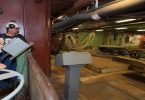Types of Anchors are:
-
Ordinary anchors
- Ordinary anchors of “stockless” type are to be generally adopted and they are to be of appropriate design in compliance with the rules or practice of each individual Society.
- The mass of the heads of stockless anchors including pins and fittings are not to be less than 60% of the total mass of the anchor.
- The mass, per anchor, of bower anchor given in Table 1 is required for anchors of equal mass.
The mass of individual anchor may vary to 7% of the Table mass provided that the total mass of anchors is not less than that required for anchors of equal mass.

